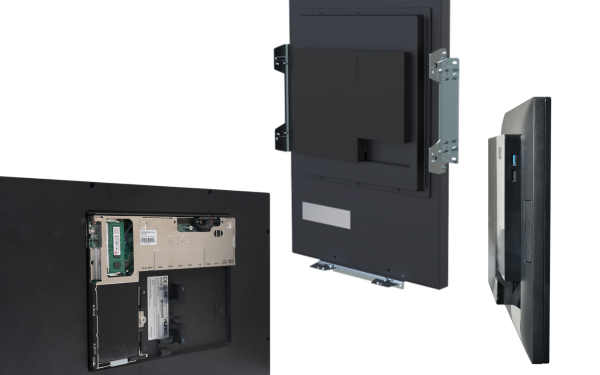Point of sale hardware has come a long way in the last couple of decades. From a world of lookalike cash registers and their electronic cousins ePOS machines, POS terminals have diversified dramatically in size, form and function.
In fact, with the arrival of self-service kiosks and mobile POS tablets, even the term ‘POS terminal’ no longer captures the variety and choice available. POS hardware is no longer a single, one-dimensional option. It’s a whole technology category in its own right, with multiple solutions available for a whole range of different requirements.
Checkout terminals, kiosks and mobile POS are the ‘big three’ of the POS category. But there’s a fourth option vying for attention – panel PCs.
In customer-facing sectors like retail, hospitality and leisure, interest in panel PCs as alternatives to conventional checkouts and kiosks has started to snowball. So what exactly are they, and what do they offer?
What is a Panel PC?
A panel PC is an all-in-one computer that combines a CPU with a built-in touchscreen. Designed to be mounted on a panel or surface, a good comparison for what they look like could be a smart TV.
Compact, convenient and versatile, panel PCs are perfect for space-constrained environments or where there’s either a shortage of or a desire to keep available surfaces clear. The fact that they can be mounted out of the way on a wall also makes them ideal in busy locations where there are a lot of people walking around and a need to avoid trip hazards.
Panel PCs were originally developed for industrial use. You can see this heritage very clearly in our own TEOS Touch models. They come housed in a robust and rugged metal casing, with an equally durable dust and waterproof front display – purpose-built for tough environments.
In industry, panel PCs are ideal for tasks such as process control and machine automation, offering the flexibility to be mounted wherever is most convenient and avoiding the hazards posed by extra cables running from CPU units to external displays etc. Similarly, panel PCs have become increasingly popular as control units for medical equipment in healthcare for tasks like patient monitoring, diagnostics and laboratory automation.
So how and why have panels PCs made the crossover into more customer-facing sectors like retail and hospitality?
Best of Both Worlds
Let’s re-cap those benefits that have made panel PCs so popular in industry and healthcare. Space-saving, convenient to use, versatile not only in terms of where they can be installed but also how they can be used – when you put it in those terms, it’s easy to see where the interest in having them in stores, restaurants, ticket halls, gas stations and many other customer-facing environments comes from.
You could even say that a panel PC combines the best of both worlds from a POS terminal and a kiosk. In a pretty literal sense. Mount an interactive touchscreen in your store, and it can be used by staff and customers alike.
Panel PCs make great information points and interactive displays where customers can look up details of products or check timetables etc. Equally, you can use them for more transactional purposes, whether that’s processing sales, placing an order for fast food, checking into a hotel and so on. They also double up as useful displays for advertising and other marketing purposes.
Then there’s the space-saving angle. We’ve mentioned how panel PCs are a good fit in environments where you want to minimize the risk of tripping over wires or are short of available surfaces to sit computer units and displays on. This is has huge appeal in smaller stores, cafes and bars. Why take up precious space with a table just to sit a POS terminal and display on when you can mount it on a wall? Same with kiosks – a lot of freestanding models are pretty big units. With a panel PC, at most you’ve got a compact screen and a pole.
At AURES, we’ve been so excited about the potential of panel PCs as POS solutions that we’ve built a mountable single panel version of our best-selling YUNO model. The YUNO Kiosk is available in 17”, 22” and 27” versions with user-friendly VESA mountings that make it easy to install either on a pole or directly on a wall.




